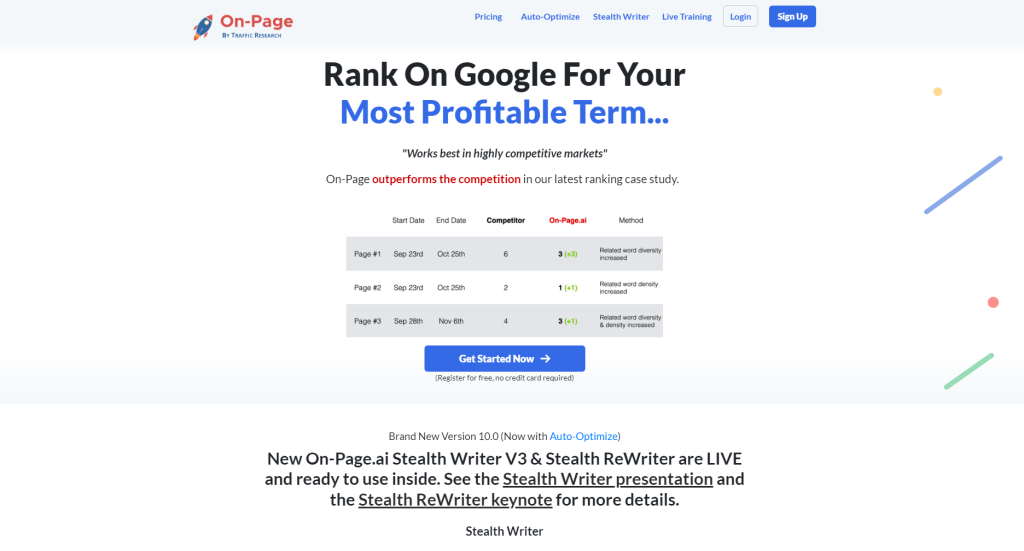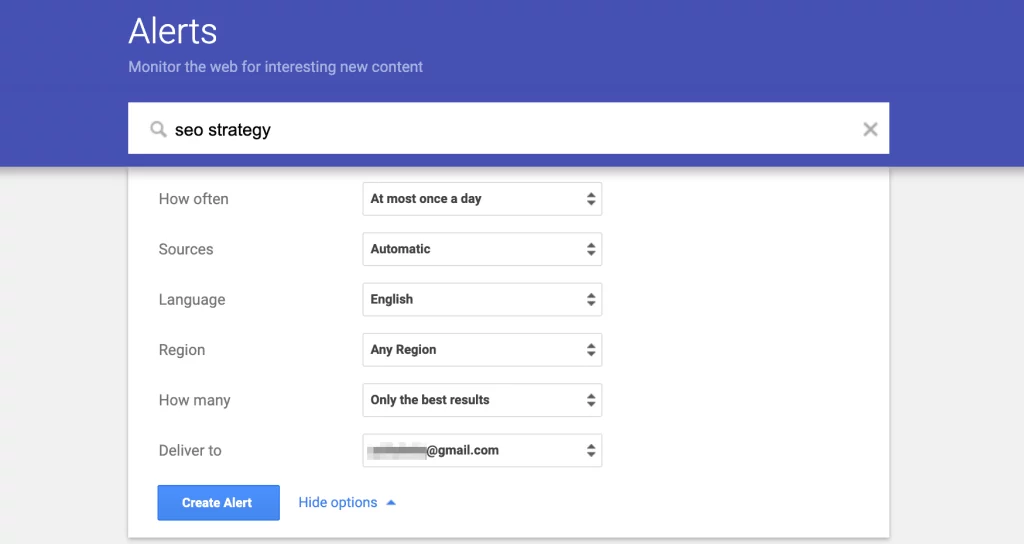How Content Freshness Boosts Your SEO: The Benefits of Regularly Updating Your Content

Imagine your website is a garden, blooming with colorful flowers and lush green plants, showcasing its breathtaking beauty to everyone who passes by. Now, let that garden represent your website’s content. Just as a well-maintained garden continues to attract more visitors, fresh and regularly updated content pulls in more users through search engines, increasing visibility and boosting SEO. Enter the world of Content Freshness, where we unravel the secrets behind this vital aspect of SEO strategy — revealing how renewed content can work wonders in engaging your audience and skyrocketing your site’s rankings on search engine results pages (SERPs). With On-Page.ai let’s explore this vital aspect of an effective SEO plan that can take your digital garden from a hidden gem to a bustling hub of cyber-visitors.
Fresh content is vital for SEO because Google’s algorithm considers it as a ranking factor. The Query Deserves Freshness algorithm determines when to serve users new information, which means that frequently updated content is more likely to appear higher in organic search results. Additionally, fresh content provides more opportunities to target keywords and attract visitors to your site, making it a critical factor in increasing your website’s authority and recognition as an industry leader.
How Content Freshness Impacts SEO
The online world is immensely dynamic, and this dynamism requires websites to regularly update their content to maintain relevance and stay competitive. Freshness of content is one of the essential factors in SEO that determines whether a website will rank at the top or not. Having new information on your website indicates to search engines that your website is up-to-date and well-managed.
For instance, when a user searches for information on a recent event or breaking news, Google strives to offer fresh content results to them instead of showing outdated ones. This means that if you’re struggling with ranking high on Google SERPs (Search Engine Results Pages), it might be time to refresh your web pages’ content.
Apart from offering your audience updated information, fresh content also signals to search engines about the quality of your site and its ability to provide relevant return results for users’ searches. Search engines use numerous ranking signals, including freshness, relevance, usefulness, and many others.
While updating your content frequently might not guarantee ranking success alone, it certainly enhances your chances of appearing at the top of search engines. However, there is no exact timeline or frequency for updating content as different niches have varying rates of freshness requirements.
To put things into perspective, imagine two restaurants trying to compete in the same market segment; one restaurant updates its menu weekly with new dishes while the other has the same menu for months. Certainly, the first restaurant stands a better chance of attracting more customers because it offers something new constantly. The same applies to websites; consistently providing fresh content is critical.
The next subtopic highlights some ranking factors vital in boosting SEO through updated contents.
Ranking Factors and Updates

When it comes to ranking factors and updates, speed is crucial as recency plays a vital role. Here are some factors that affect SEO through content freshness:
1. Query Deserves Freshness (QDF): QDF algorithm is Google’s tool that attempts to display the newest and most relevant results for specific queries.
The QDF feature works best with queries that require updated information-like breaking news, current events, time-sensitive trends, and recurring events. So if you want your website to be recognized by QDF, updating your content regularly is essential.
Imagine someone searching for the latest news on an unfolding political event. Google will prioritize providing fresh content from a reputable site with up-to-date information over stale information from previous days old posts.
2. Outdated Content: Websites with outdated content risk being penalized in their search engine rankings.
Search engines consider fresh content as more valuable to searchers than old content. While old content will still rank relatively highly, newer and fresher content is likely to rank higher.
For instance, imagine you’re searching for the 10 best smartphones 2022 for purchasing advice but instead end up stumbling on a trap article titled “The 8 Best Smartphones of 2018.” Most people looking attentively for buying recommendations probably close the page and look somewhere else.
3. Links: Link building has always been an effective SEO tactic, but it’s worth noting that acquiring links to outdated or stale pages may not be useful.
Getting links from external sources pointing to updated pages signals to search engines that the website is active and dynamic.
For instance, imagine you discovered a broken link while checking out competitor backlink profiles; however, when checking out the cited source’s webpage, you notice that it hasn’t been updated since 2014. Would you still link your website there? Probably not.
- A study conducted by Moz in 2022 revealed that there was a direct correlation between content freshness and higher search engine rankings, with fresh content contributing to better visibility on search engines.
- According to a HubSpot analysis from 2020, websites that updated and republished old content witnessed an average increase of 106% in organic traffic compared to those that did not optimize existing content.
- In the same HubSpot research, it was found that websites publishing at least 16 high-quality, fresh articles per month received 3.5 times more organic traffic than those publishing four or fewer articles within the same time frame.
Improved User Experience
One of the most crucial aspects of SEO is user experience. And, content freshness can have a significant impact on user experience. When your website keeps churning out new content, users are more likely to stick around, find value in what you offer, and engage more with your brand.
To understand this better, imagine visiting a website that hasn’t been updated for ages. The content is outdated, and the design is obsolete. Would you stay long enough to get what you’re looking for? Probably not. You’d quickly leave in search of a better resource that offers relevant information.
In contrast, sites that regularly update their content offer a much better user experience. Users are more likely to return to those websites and spend more time there because they know that they’ll find something new and interesting each time.
Additionally, frequent updates indicate that the site is trustworthy and credible. For instance, if you run a blog about technology news but don’t publish anything new for months, readers may begin to question whether you’re still an expert in that field or whether your website is even active at all.
On the other hand, regular fresh content shows that your brand is active and invested in offering useful information to its users. Users are therefore inclined to trust your site more as an authority in its niche.
Some people might argue that updating content frequently could lead to lower quality output as writers rush to meet deadlines. However, there are ways to maintain high-quality standards while still keeping up with the frequency of updates. For instance, brands can outsource content creation to experienced writers who can produce high-quality pieces consistent with their brand voice.
Now that we understand how freshness can improve user experience let’s dive into why maintaining fresh content matters.
Why Maintaining Fresh Content Matters

Fresh content benefits businesses in many ways. Here are the two most significant ones:
Google uses E-A-T (Expertise, Authoritativeness, and Trustworthiness) as a ranking factor in its algorithm. When you maintain fresh content regularly, your website is more likely to be seen as relevant and authoritative in your niche. That recognition will make it easier for your site to rank higher on search results.
The more pages that get updated or added on your site, the more frequently Google’s crawlers come back to check things out. This leads to frequent indexing of your site and ultimately boosts SEO performance.
Additionally, regularly updated content can help businesses keep up with changing audience needs. For example, there may be new developments in your industry or questions that your customers frequently ask. Updating content can help brands address these changes and provide users with insights into current information.
Imagine owning a clothing store that has no new stock for months; customers would eventually stop visiting because they’d have the impression that nothing new is happening in the shop. However, if the store owner updates their inventory weekly and showcases new items on social media platforms, customers will be constantly checking back to see what’s new.
The same principle applies to websites – when you offer something fresh regularly, visitors will keep coming back for more.
Gaining Authority in Your Niche
One of the most significant benefits of regularly updating your content is gaining authority in your niche. When you publish fresh, high-quality content consistently, you create an impression that you are on top of things and are a serious player in your industry. This sends a positive signal to search engines, as it establishes your website as a credible source of information. Try using On-Page.ai for a fresh content creation for your needs.

Let’s say you run a food blog that mainly focuses on vegan recipes. If you have been consistently posting new, interesting recipes over the years, search engines would identify your site as an authority for vegan recipe content. As a result, your blog could rank higher than others when someone searches for “vegan recipes” online.
In addition to improving your search engine ranking, gaining authority in your niche can bring additional benefits. For instance, if people start viewing you as an expert in your field, they are more likely to trust and recommend your content to others. This further enhances the reputation of your brand and makes it easier for you to attract new visitors to your site.
However, some may argue that gaining authority takes time and that there are other ways to obtain it beyond just consistently publishing content. While it is true that becoming an authority requires sustained effort and investments in other areas such as marketing and outreach, producing quality content is undoubtedly one of the foundational steps for establishing yourself as an expert.
Updating old content can also play a crucial role in gaining authority. Just like how companies refresh their branding by updating their logos or changing their website design, refreshing outdated content can give your website a major facelift and make it appear modern and relevant. This makes it stand out from others doing similar work and creates an updated profile of the niche that will enable better user satisfaction and hence greater traffic in due course.
- Consistently updating your content with fresh, high-quality material can help establish your website as an authority in your niche. This not only improves search engine rankings but also enhances the reputation of your brand and makes it easier to attract new visitors. Refreshing outdated content is also crucial for keeping your website relevant and standing out from competitors. While becoming an authority takes time and effort, producing quality content is a foundational step towards establishing yourself as an expert in your field.
Frequent Indexing by Search Engines
Another major benefit of freshness in content is frequent indexing by search engines. When you add or update content on your site, it sends a signal to search engines that your site is active and worth paying attention to. If the updated content is high-quality, timely, and original, the search engine might rank it higher in search results.
Let’s refer back to our vegan food blog. Suppose you post a recipe for a delicious beetroot burger today. Since the recipe is fresh, search engines might index it quickly, making it show up in search rankings when people search for “vegan burger recipes.” As a result, your site will be noticed by more users.
This frequent indexing can increase your website’s traffic by giving you more chances to appear at the top of the rankings for specifically themed articles within your niche. This could ultimately lead to high click-through rates, boosts in user engagement with effective upselling opportunities through CTA integration and potentially new customers.

However, some may argue that not every type of content needs to be updated frequently. For some static web pages like “About Us” or “Contact Us,” regular updates are not necessary. But even then, adding original and useful information to static pages every once in a while can also benefit your site’s SEO. It shows search engines that you have an active website that cares about providing relevant information for its audience.
Think of it like nurturing relationships with friends and acquaintances; if you remain dormant with no contribution to personal interaction for too long a period, people will start losing interest in you as they deem that there’s nothing interesting going on in your life anymore which serves as the basis for reducing the credibility of your opinion’s value towards them. Similarly updating a website with fresh content gives Search Engine bots a reason to remain interested in your website.
Key Factors Influencing Content Freshness

Keeping your website content fresh is a crucial factor in improving its SEO rankings. However, it’s important to understand what determines the freshness of your content and how search engines evaluate it. While no single formula can determine freshness with certainty, several factors influence it.
- One critical factor is the time-sensitive nature of the content. Some topics like news, events, and industry trends require constant updates to remain relevant in search results. Frequently updating content related to these topics helps Google realize that your site provides up-to-date information and is worth crawling regularly.
- Another critical factor determining content freshness is its relevance and usefulness to users. Content that serves a specific purpose or solves a problem for readers is more likely to remain fresh than generic content that speaks to a broad audience. When you offer unique valuable insights or offer solutions to common problems, search engines classify your pages as authoritative content sources that must be regularly updated.
- For instance, a travel blog that constantly publishes new posts on current tourist hotspots and attractions will appear more fresh than an older piece on an already saturated topic. Travel blogs that publish evergreen pieces such as on how to pack for a trip don’t require frequent updates since their information remains relevant over time.
- Additionally, user engagement doesn’t only influence how long someone stays on the site but has an impact on content freshness too. User-generated content such as comments serves search engines as proof of content relevance. It shows Googlebots that people are finding value in this piece and might act as influencers in ranking algorithms.
Although the frequency of posting new articles or updating pages affects freshness, there’s no hard and fast rule regarding how often sites should be updated with new data. However, continuously providing value with quality content has become essential for gaining better ranking positions in Google’s SERPs. A company that deals with legal content could have evergreen pages on their site that do need to be updated frequently with new information. However, at the same time, pieces on news topics related to their niche might require several updates throughout the day.
Timeliness and Regular Updates
Besides generating fresh content, search engines consider how regularly content is updated. The frequency of updates depends on the type of website and nature of the content posted there.
Regular updates create a sense of urgency, conveying to search engines that your site is actively managed and contains relevant information for users. If the site remains unchanged for an extended period, Google assumes it has become outdated and less valuable over time.
Creating a schedule for updating pages helps you stay disciplined and ensure your site stays fresh. This way, Google can recognize the added effort put in by site owners to make sure data provided to readers is up-to-date.
Consistent updating helps retain existing traffic as readers return often to find out what’s new on the site. Multiple visits increase time spent on page metrics and provide an opportunity for higher engagement rates, leading to better ranking outcomes.
Comparing a website to a storefront in a mall, imagine two shops side-by-side selling similar products. One shop displays signs indicating current sales or occasional events; meanwhile, the other rarely changes its appearance or merchandise window displays. Similarly, the second store would probably not attract up-to-date customers compared to the first store because it lacks appeal through freshness or versatility.
- Although knowing how often a website should update isn’t clear-cut, neglecting frequent content refreshes can hurt rankings severely. Search results featuring pages that haven’t been updated recently are likely less reliable and don’t appear trustworthy from users’ perspective.
Effective Strategies for Content Freshness

Updating your website with fresh and relevant content is critical to your SEO strategy. However, it can be challenging to come up with new ideas consistently, especially if you have already covered many topics in your industry. Here are some effective strategies to help you maintain fresh content on your website.
- First, consider repurposing older posts by updating them with new information or adding multimedia elements such as images and videos. This approach is beneficial because it allows you to build upon existing content while keeping it relevant and informative. It also saves you time and effort creating an entirely new article from scratch.
- Second, conduct regular keyword research to identify new opportunities for fresh content. Start by analyzing top-performing keywords in your niche and create content that reflects those search terms. This way, you are not only staying current on the latest trends in your industry but also targeting high-value keywords that can bring in more traffic.
- Arguably one of the most effective strategies for maintaining fresh content is to engage with industry peers through guest posting. By contributing a guest post on another site in your niche, you can reach a broader audience while also establishing yourself as an authority figure in your field. However, this can be a time-consuming process as you must build relationships with other bloggers first before pitching a guest post idea.
- Another valuable strategy for maintaining fresh content is to leverage customer feedback and queries. Think of customer feedback like gardening: These suggestions provide fertile soil for planting new seeds (ideas) that can grow into informational articles or guides. Use customer feedback surveys to gather data and generate ideas then put these ideas into action.
Updating Existing Content
Now that we have covered some effective strategies for maintaining content freshness let’s delve into how updating existing content regularly is crucial to SEO success.
Consider breaking up your existing long-form content into smaller pieces that are easier to digest. People have a shorter attention span and are more likely to read snackable articles or blog posts. This allows you to get more mileage out of your existing content while also creating fresh material.
Updating outdated information is another effective way to keep your existing content fresh. Periodically review older articles and blog posts for any outdated information, statistics or references and update them accordingly. This not only keeps your content current but also helps eliminate any negative SEO implications from having outdated information on your site.
Some argue that simply updating the date of an article is sufficient to maintain freshness; however, this is not always the case. While visitors may appreciate updated information and timestamps, it’s more important to update the content itself with new information and insights rather than just adding a new date.
Adding High-Quality New Content
Adding high-quality content to your website is one of the most effective strategies for improving your search engine rankings. This not only means producing new, valuable content, but also optimizing it for SEO purposes. By providing readers with informative and helpful articles, your website can become a go-to resource in your industry or niche. Here are some effective strategies to add high-quality content to your website:
- First, consider creating evergreen content that will remain relevant and useful for years. This content should be based on topics and information that are always in demand and unlikely to change significantly over time. Evergreen content may include how-to guides, tips and tricks for problem-solving, and in-depth analysis of industry trends.
- Second, focus on creating original research that provides new insights into your industry. Original research can involve surveys, studies or experiments that shed new light on an issue within your industry. Such research can become a valuable resource for other websites, thereby increasing traffic and establishing authority in your niche.
- Third, consider guest posting on other websites as it helps to build relationships with other websites while at the same time increase backlinks to your website which is important for SEO practices. Backlinks are seen by search engines as indications of relevance and authority.
- Finally, don’t underestimate the importance of visuals in enhancing the appeal of content on your website. Adding images or videos can help you convey complex ideas or concepts effectively while delivering visual stimulation to readers.
In conclusion, adding refreshing high-quality content is an essential strategy to stay ahead of competitors and improve your website’s ranking on Google. Through evergreen content, original research, guest posting and the use of visuals, you can offer readers valuable resources while increasing organic traffic to your site. As an effective SEO optimization tool powered by Artificial Intelligence, On-Page.ai can help you identify areas where your website can improve and provide recommendations for optimizing your content.
Answers to Common Questions with Explanations
Does the frequency of content updates affect search engine rankings?
Yes, the frequency of content updates does affect search engine rankings. According to a study by HubSpot, companies that published 16 or more blog posts per month received 3.5 times more traffic than those that published only 0-4 posts per month.
The reason frequent updates boost SEO is that search engines prioritize fresh, relevant content over old and outdated content. By regularly updating your website or blog with new content, you signal to search engines that your website is active and authoritative. This can lead to higher search engine rankings and increased organic traffic.
In addition, updating existing content with new information or optimizing it for target keywords can give a boost in rankings as well. Google’s algorithm favors websites that provide the best user experience, which includes providing updated and relevant information.
Overall, investing in regular content updates can have a significant impact on your SEO results.
Can outdated or stale content negatively impact website traffic and engagement?
Yes, outdated or stale content can definitely negatively impact website traffic and engagement. In fact, Google has explicitly stated that they favor fresh and updated content in their search algorithms. According to a study conducted by HubSpot, websites with updated blogs receive 126% more leads than those without. Additionally, consumers prefer fresh content when it comes to making purchase decisions, as reported by Adobe in a survey which found that 59% of people prefer custom content that reflects the most recent news or trends.
Moreover, stagnant content can lead to a decline in user engagement on your website. If users see the same old content every time they visit, they may lose interest in your website and not return. Alternatively, if your competitors are regularly updating their content, users may choose to go elsewhere for fresh and relevant information.
It’s important to note that updating content doesn’t necessarily mean completely rewriting everything on your website – even small updates or tweaks can make a significant difference. The key is to ensure that your website stays relevant and valuable for your audience. By doing so, you’ll keep them engaged while simultaneously improving your SEO performance.
How often should website content be updated to maintain freshness?
There is no one-size-fits-all answer to how often website content should be updated. However, most experts recommend updating your content at least once every six months. This will help you maintain relevance and authority in your niche, which can translate into higher search engine rankings.
It’s worth noting that the quality of your content matters just as much as the frequency of updates. Only publish content that provides value to your audience and reflects your expertise. If you’re struggling to come up with new ideas for content, consider repurposing or updating existing posts rather than starting from scratch.
Ultimately, there’s no magic formula for how often you should update your website content. It depends on your industry, audience, and goals. The key is to strike a balance between frequency and quality, while always keeping your audience’s needs and interests first and foremost.
Are there any tools or strategies to help keep website content fresh?
Absolutely! There are several tools and strategies that can help you keep your website content fresh, up-to-date, and engaging.
One strategy is to conduct regular content audits to identify outdated or irrelevant content that needs to be either updated or removed. This will ensure that your site provides high-quality information for visitors.
There are also several online tools available to help you monitor changes in your industry and stay on top of emerging trends. Google Alerts, for example, allows you to receive updates on relevant topics straight to your inbox.

Finally, social media platforms like Twitter and LinkedIn can be great sources of inspiration for fresh content ideas. Following industry leaders and participating in online conversations can help you stay informed and engaged with your audience.
In short, keeping your website content fresh requires a combination of strategic planning, regular updates, and staying tuned in to industry news and trends. By doing so, you’ll not only improve your SEO but also provide real value for your visitors – and ultimately boost conversions and sales.
What types of content benefit most from frequent updates?
Great question! While all types of content can benefit from regular updates, some types tend to see more benefits than others.
Firstly, product pages are another type of content that benefits greatly from regular updates. In fact, a study by Ahrefs found that websites with outdated or stale product pages experienced a significant drop in Google rankings compared to websites with regularly updated product pages. By keeping your product pages up-to-date with new information, images, and customer reviews, you can improve your visibility on search engines and ultimately drive more sales.
Lastly, evergreen content – content that remains relevant and informative over time – should also be regularly updated to ensure it stays current and accurate. According to Orbit Media Studios, updating old blog posts with new information and statistics can lead to a 106% increase in organic traffic within two weeks.
In conclusion, all types of content can benefit from regular updates; however, blog posts, product pages, and evergreen content tend to show the most significant improvements in SEO performance when kept fresh with new information. Your best choice is definitely On-Page.ai




